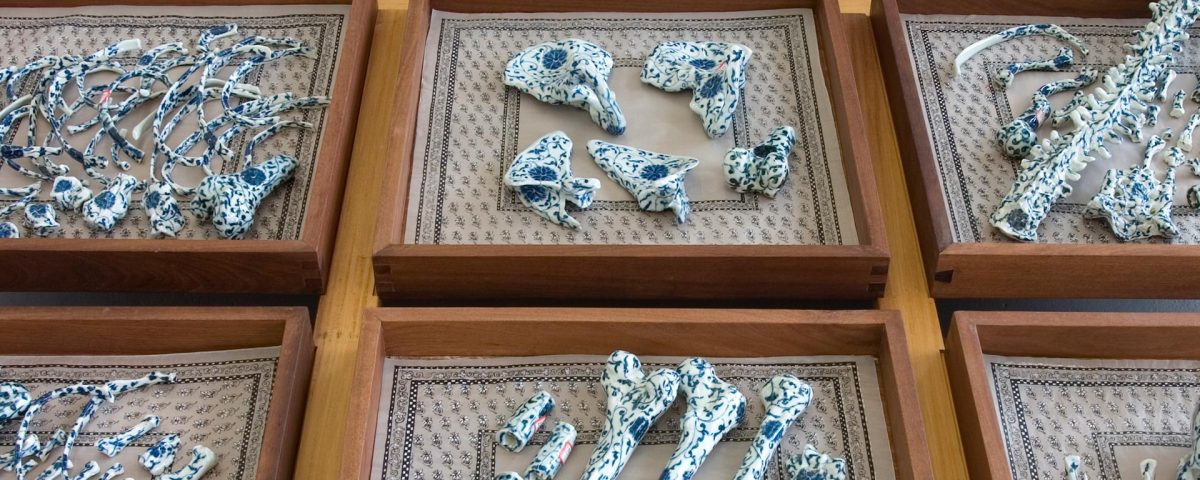
YANG JIECHANG
04/09/–17/10/2010
Born in 1956 in Guangdong Province, Yang Jiechang currently lives and works in Heidelberg and Paris. After graduating from the Guangzhou Fine Arts Academy in 1982, he took up a rigorous study of the Tao with the Taoist master, Huangtao. Simultaneously he became active in the contemporary art scene in China which was then undergoing rapid development. One of his aims is to promote autonomous regional and marginal expression. Yang Jiechang gained international recognition through the exhibition of his large monochrome ink paintings, severe in their abstraction and spirituality, in “Les magiciens de la terre” in the Centre Pompidou in Paris in 1989. Nevertheless, his œuvre comprises a variety of media: painting, video, installation, and interventions.
Excerpts from Hou Hanru´s text “Towards a World of Poets”*:
Yang Jiechang is probably the most unpredictable and chaotic artist in his generation. For the last thirty years, he has constructed an immense body of work. It covers a large span of media and languages from ink-wash painting, Chinese calligraphy, drawing, photography, installation, performance, sound, music, multimedia to simply everyday actions while the formats vary from huge and oversized to tiny and quasi immaterial. However, he has never tightened himself to any fixed and established style, norm and issue. Instead, he always reacts to the given context and momentum of each events in which he participates and produces new concepts and forms to put forward his systematically critical, provocative and even subversive thoughts and expressions. He simply comes up with a new surprise every time.
I(…) In the last century, “reforming” Chinese traditional painting (ink painting) has been an unsolved and somehow unsolvable obsession for the Chinese art world. It has been widely considered as a part of the national mission of cultural modernisation. This issue became even more crucial and urgent in the Chinese avant-garde movement of the 1980s. Trained as an ink painter and calligrapher, Yang Jiechang started his artistic career in involving himself with the debate. After gaining perfect skills of traditional painting and calligraphy and a deep knowledge of Chinese art history and theory, he sought to escape from the double confinement of the academic rules and the norms of the dominant Socialist Realism still prevailing in the art world, in order to obtain the real freedom and joy that art can offer. He spent a considerable amount of time in a Taoist temple in Luofu Mountain in Guangdong province and learned Taoism with a master. Instead of any fixed form of “traditional expression”, he has learned that the real spirit of the tradition is to be found in the actions of the everyday which is in infinite change. Unlike many of his contemporary avant-gardists who claimed the death of the Chinese ink painting, Yang Jiechang simply continues to merge himself in the field and explores exhaustively all possibilities that the tradition can offer and invent totally new ways to utilise it. Ink painting and calligraphy have hence remained the red string that conducts all his artistic adventures for the last three decades. And, it will continue to be so. In his numerous work, he incorporates all genres that ink painting contains and push them to the most radical degree of their possibilities.
(…) In addition, all these explorations of the expressions with ink are often expanded to take over the entire space of the exhibition as if their expansions could be totally beyond any boundary. Frequently, he incorporates any imaginable kind of media to bring this effort of expansion infinitely further: performance, installation, photography, video and even rock and roll!
Fundamentally, Yang Jiechang’s work is seeking for a complete merge of art and life. It takes place, at first, in the real in a literal sense of the term: art is a process of living experience that can only be sensed through the body itself. (…)
In many of his recent works, he introduces human skulls and body parts. Rather than showing the terror of death, he manages to turn them into suspiciously playful and ironic forms that provoke astonishment and laughter. For him, putting the body in an “abnormal” state and catch the extraordinary experience is certainly the best way to understand the very reality of his existence. This can be understood in a particular perspective related to his own life experience, which is, to different extends, shared by a great number of his contemporaries. As one of the first generation of Chinese contemporary artists settled abroad since the late 1980s, the question of cultural identity has been a central concern in his life and work. Like many of his colleagues, Yang Jiechang has never been entirely relying on his Chinese background. Instead, he adopts a completely open attitude towards all kinds of cultural influences that he encounters in his new living conditions consisting of a multi-national family, global city life and transcontinental travels. It’s in the very process of confronting, embracing and exchanging with other cultures and different living realities that he has been constantly trying to reinvent his own identity.
*Yang Jiechang – No-Shadow Kick, Beijing / Hong Kong / Bangkok / Shanghai 2008
